The Green Dubai: Sustainable Urban Living Insights
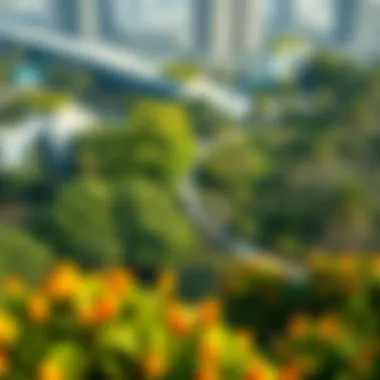
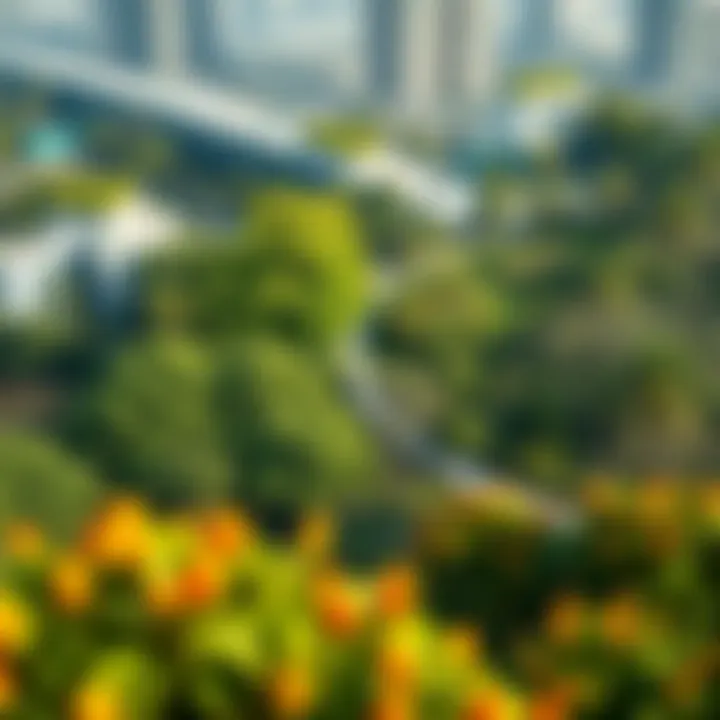
Intro
Dubai has donned a new jacket. It’s one that's not only stylish but also eco-friendly. With the Green Dubai initiative, the city is taking bold strides towards sustainability, making it a model for urban living in the 21st century. The skies may be filled with skyscrapers, but they're accompanied by a growing canopy of greenery and eco-conscious choices that are reshaping daily life. This deep dive aims to unravel the threads of sustainability woven into the very fabric of Dubai’s urban landscape. "Going green" isn't merely a trend here; it’s becoming a way of life, influencing everything from community interactions to everyday amenities.
As we explore The Green Dubai project, we will shed light on the innovative practices aimed at enhancing green spaces, advocating for eco-friendly transportation, and embracing energy-efficient habits. Educational programs and active community involvement lie at the core of this initiative, serving as catalysts for widespread change. It’s not just about planting trees or building parks; it’s about fostering a culture that values and prioritizes sustainability in all aspects.
This exploration will cover several key areas:
- Local cultural practices and community engagement that support a greener agenda.
- The transformation of lifestyle amenities through sustainable practices.
- Insightful perspectives from residents, expatriates, and visitors who engage with these initiatives daily.
By the end of this journey, readers will grasp the broader implications of sustainability in urban life in Dubai, appreciating the city's efforts to become a greener metropolis. Let's embark on this enlightening path as we uncover the layers behind Green Dubai.
Prelude to The Green Dubai
Dubai stands at a crossroads where ambition meets environmental consciousness. The initiative known as The Green Dubai is not just a buzzword; it is a commitment to reshape urban living in a way that emphasizes sustainability, both for current residents and future generations. This article takes a closer look at how the desert city integrates green initiatives into its bustling urban fabric, offering insights into how these efforts shape daily life.
Sustainability in Dubai goes beyond aesthetic greenery or the planting of palm trees. It encompasses a broad spectrum of practices aimed at reducing the carbon footprint of this mega city. Urbanization has led to soaring populations and increasing strain on resources, making it imperative for cities like Dubai to invest in innovative sustainability measures. The primary question this article seeks to answer is: how do these initiatives benefit not just the environment but also the quality of life?
In direct response to climate change and urban challenges, The Green Dubai develops systems that promote energy efficiency, sustainable transportation, and innovative architecture. By prioritizing green initiatives, Dubai aims to attract not only tourists and expatriates but also global recognition as a leader in sustainable urban living.
Defining Sustainability in Urban Context
Sustainability, when viewed through the lens of urban living, often highlights the balance between economic growth and environmental stewardship. In a place like Dubai, where opulence frequently overshadows conservation, sustainability seeks to disrupt that narrative. It is about creating an urban environment where natural ecosystems can coexist with human industries.
This encompasses several key principles:
- Resource Conservation: Using water and energy efficiently
- Waste Management: Minimizing waste through recycling and reducing what goes to landfills
- Ecosystem Restoration: Rehabilitating natural habitats affected by urban development
An example could be the introduction of stormwater management systems and rainwater recycling, which are crucial in a city known primarily for its arid climate.
In essence, sustainable urban development requires a holistic view of the city’s infrastructure and environment, mitigating adverse effects on nature while enhancing the living conditions of its populace.
The Importance of Green Initiatives in Mega Cities
The role of green initiatives becomes even more pronounced in mega cities such as Dubai. With thousands flocking to the city each year, the environmental strain amplifies. Highlighting the need for a shift towards sustainability, green initiatives not only cater to environmental regulations but also improve residents’ quality of life.
A few critical benefits of these green efforts include:
- Healthier Living Environments: Access to parks and green spaces can significantly enhance public health. Studies show that urban greenery correlates with reduced stress levels and better mental health.
- Economic Benefits: Sustainable practices, like energy efficiency and waste reduction, can lead to significant cost savings for both the government and private residents.
- Increased Community Engagement: Initiatives encouraging local participation foster a sense of ownership and responsibility among residents, enhancing community solidarity.
From lush parks sprinkled throughout the metropolis to ambitious projects like community gardens, the dialogue around these initiatives suggests that a greener future in Dubai can lead to a more harmonious relationship between the city and its inhabitants.
"Green initiatives aren't just a nice-to-have; in a rapidly evolving urban landscape, they become critical components in shaping sustainable futures for all."
Through this lens, The Green Dubai push not only showcases a commitment to a sustainable future but also embodies a cultural shift towards a more responsible way of living in urban settings.
Dubai's Vision for Sustainability
Dubai's ambitious vision for sustainability is at the heart of its evolution into a greener city. The emirate recognizes that as urban areas expand, they must also prioritize ecological balance. Here, sustainability is not just a buzzword; it is a multifaceted approach that integrates environmental, social, and economic elements to create a thriving metropolis.
The commitment manifests in various ways, from improving public transport systems to investing in renewable energy sources. One important factor in this pursuit is the continuous dialogue between government agencies, urban planners, and the community at large, aiming to cultivate a sense of shared responsibility.
Inspired by global environmental standards, Dubai's approach includes a roadmap for enhancing the urban landscape while minimizing the carbon footprint. This roadmap connects city-wide policies and specific initiatives, illustrating that going green is a vital strategy for the future.
"Dubai is designing a framework where sustainability is woven into the fabric of everyday life, influencing not only the urban planning but also the consciousness of its residents."
A Government's Commitment to Environmental Goals
The Dubai government has laid down a robust framework toward achieving sustainable urban living. This commitment can be observed through the establishment of the Dubai Clean Energy Strategy 2050, which envisions that 75% of Dubai's energy will come from renewable sources by the middle of the century.
This strategy stems from several pressing concerns:
- Diminishing Water Resources: The need to address water scarcity makes it essential to implement programs aimed at water conservation and recycling.
- Air Quality: The focus is on reducing emissions from vehicles and factories, which requires stringent policies and real-time monitoring systems.
- Public Awareness: For sustainable goals to take root, there is an ongoing need for educational initiatives that galvanize residents into taking actionable steps towards sustainable practices.
In terms of governmental initiatives, Dubai has undertaken significant projects such as the Dubai Green Building Regulations to ensure that new constructions comply with sustainable principles. Regular audits and performance assessments are in place to maintain these standards, ensuring that both old and new structures contribute positively to the environment.
Strategies for Integration of Green Practices

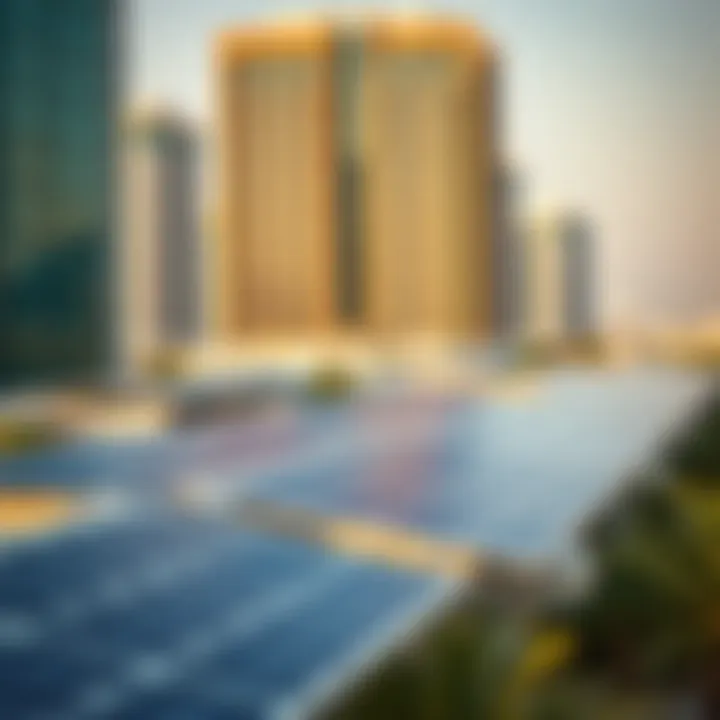
To see the vision of sustainability through, integration of green practices into various sectors is crucial. Several key strategies are in place, each focusing on an aspect of urban living.
- Sustainable Urban Planning: The city aims to create a balanced environment where nature and development coexist. This includes zoning laws that promote mixed-use developments with ample green spaces.
- Transportation Networks: Dubi has invested heavily in expanding its public transport systems—including metro systems, buses, and water taxis—to reduce reliance on private vehicles, thereby curbing emissions.
- Community Involvement: Encouraging residents to participate in sustainability efforts is central to Dubai's strategy. Initiatives such as volunteering programs and educational workshops foster a culture where individuals take an active role in environmental conservation.
- Incentives: Financial incentives for those adopting renewable energy solutions in both commercial and residential properties facilitate a quicker shift towards green technologies.
Through these strategies, Dubai is not just transforming its cityscape but also ensuring that its citizens are integral to the journey toward a sustainable future.
Green Spaces in Dubai
Green spaces form the backbone of Dubai's ecological strategy. They breathe life into urban areas, contributing significantly to the quality of life for residents, expatriates, and visitors alike. Even in a city renowned for its skyscrapers and luxury developments, the inclusion of parks, vertical gardens, and community gardens speaks volumes about Dubai's commitment to fostering a sustainable environment. These spaces not only enhance the city’s aesthetic appeal but also play a crucial role in combatting urban heat, improving air quality, and promoting community engagement.
Parks and Recreational Areas
Parklands scattered throughout Dubai serve as oases amidst the concrete jungle. They offer a getaway for families, fitness enthusiasts, and anyone seeking a breather from the hustle and bustle. The parks are often equipped with facilities for jogging, biking, and other outdoor activities.
- Al Barsha Pond Park: This expansive area not only has lush lawns but a lovely pond that invites both wildlife and visitors to enjoy nature.
- Zabeel Park: Home to the Dubai Frame, it combines cultural significance with recreational opportunities.
- Safa Park: A favorite among locals for picnicking, walking trails, and the fantastic views of the Dubai skyline.
The contributions of these parks go beyond their surface allure; they are havens for biodiversity. Various native plants and bird species find refuge in these green areas, thus enriching the ecosystem. Parks also serve as educational hubs where children learn about nature, fostering a new generation that appreciates sustainability.
Vertical Gardens and Green Roofs
As Dubai pushes the envelope on architectural innovation, vertical gardens and green roofs are becoming ever more prevalent. These structures integrate greenery into building designs without taking up extra ground space—a brilliant solution in a landscape where real estate is at a premium.
For instance, the One Za'abeel project stands out. Not only is it set to be one of the tallest buildings in the world, but its design incorporates a vertical garden that enhances both its beauty and environmental efficiency.
- Vertical gardens absorb CO2 and produce oxygen, improving air quality.
- They provide insulation for buildings, reducing energy consumption required for heating and cooling.
- The aesthetics can uplift the mood of the locals, drawing them into their own urban environment with pockets of greenery.
In a place like Dubai, where temperatures can soar, having any green space—especially vertically—is like finding gold.
Community Gardens: Engaging Residents
Community gardens represent a grassroots approach to sustainability, allowing residents to grow their own herbs and vegetables right in their neighborhoods. They foster a sense of togetherness and responsibility among residents of different backgrounds. Simply put, these gardens are way more than patches of soil; they are lively forums for education and socialization.
- Many community gardens include educational programs for children and adults, teaching them about the importance of sustainable practices.
- Residents often gather for workshops on topics such as composting and efficient water usage, blending social interaction with environmental stewardship.
- These spaces can alleviate some level of food insecurity, as they offer fresh produce right to the doorsteps of the community.
The importance of green spaces in Dubai cannot be overstated. They offer refuge from the urban sprawl, opportunities for recreational activities, and avenues for social interaction. Furthermore, as the movement toward sustainability deepens, these areas are not just parks or gardens; they are essential components in the city’s effort to balance development and ecology.
Sustainable Architecture and Design
Sustainable architecture and design play a crucial role in shaping urban living, particularly in a rapidly growing city like Dubai. It’s not just about creating visually appealing buildings; it’s about integrating functionality with environmental consciousness. This practice aims to minimize the ecological footprint of structures while providing comfort, durability, and style. It encourages the use of renewable resources, promotes efficient energy use, and fosters a connection between inhabitants and their environment.
The significance of sustainable architecture can’t be overlooked as urban populations swell. With an increase in residents and tourists, the demand for housing and structures rises, resulting in heightened energy consumption and waste generation. Therefore, architects, planners, and developers have a responsibility to implement designs that not only meet spatial needs but also respect and utilize nature. This approach leads to a healthier urban ecosystem and supports initiatives aimed at combating climate change.
Eco-Friendly Building Materials
Utilizing eco-friendly building materials is a cornerstone of sustainable architecture. These materials include recycled and locally sourced items that reduce the carbon footprint associated with transportation and production. For example, bamboo, known for its fast growth and resilience, serves as an excellent alternative to traditional timber. Additionally, recycled steel or concrete not only diverts waste from landfills but also lowers the overall environmental impact of construction projects.
Building with such materials doesn’t merely get a green stamp. It can also translate to economic advantages for developers and homeowners through reduced operational costs. Utilizing materials that require less energy for heating or cooling can significantly lower utility bills.
Energy-Efficient Designs in Residential Structures
Energy-efficient design is another pivotal aspect of sustainable architecture, especially in residential buildings. This entails thoughtful layout planning, orientation, and shading techniques to optimize natural light and reduce reliance on artificial heating and cooling. For instance, having larger windows facing north or south allows for natural light to flood in, while overhangs can protect from excessive heat during the summer months.
Incorporating smart home technologies further enhances energy efficiency. Prognostic tools can help homeowners monitor and manage their energy consumption, allowing for better energy conservation practices. The integration of energy-efficient HVAC systems or solar panels contributes to a greener living space and more sustainable way of life.
Innovative Projects: A Case Study
Museum of the Future
The Museum of the Future stands as a beacon of sustainable design, marrying innovation and environmental responsibility. One of its key characteristics is its circular form, symbolizing a commitment to a sustainable future. The building not only showcases cutting-edge exhibits but also features a design that utilizes energy-efficient systems throughout its infrastructure.
A unique aspect of the Museum is its solar-powered facade, which harnesses natural energy to power the building. This advance leads the charge in reducing the museum's dependence on non-renewable resources, making it a beneficial model for other projects aiming for sustainability.
Dubai Creek Tower
Dubai Creek Tower, another remarkable project, illustrates Dubai's ambition to blend luxury with sustainability. Expected to be one of the tallest structures in the world, this tower incorporates various environmentally friendly practices. A key feature of the design is its observation deck, which minimizes energy use by optimizing views and natural lighting. The tower’s structural composition includes a cooling system that mimics the natural wind currents of its surroundings, thus decreasing energy consumption significantly.
Nonetheless, colossal projects like this come with their own set of challenges. While visually stunning, the environmental cost of materials and the energy required for construction could counter the sustainable advantages. Yet, by focusing on features that promote green living, Dubai Creek Tower strives to inspire future architectural endeavors, setting the bar high for skyscraper sustainability.
"Sustainable architecture is not just about saving resources; it's about creating a better quality of life in urban spaces."
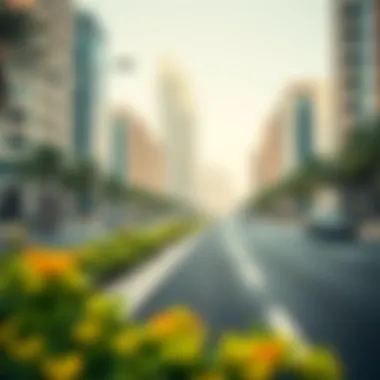

Overall, as Dubai progresses towards its sustainability goals, the fusion of innovative architecture and designs clearly reflects the city's commitment to fostering an eco-friendly urban ecosystem.
Transportation and Mobility Initiatives
Transportation plays an essential role in shaping not only the urban landscape but also the lifestyle of its residents. In a city like Dubai, where rapid development meets ambitious sustainability goals, the need for innovative and eco-friendly transport solutions is critical. Improved transportation and mobility initiatives contribute to reducing the city's carbon footprint, enhancing the quality of life and promoting sustainable tourism. As the world grapples with climate change, embracing greener transport options in Dubai becomes more than just a necessity—it's the future.
Public Transport: A Shift Towards Eco-Friendly Options
Dubai's public transport system has seen a significant overhaul aimed at reducing emissions and easing congestion. The Dubai Metro stands out as a prime example of this transition. It's a lightweight, driverless train system that connects vital parts of the city through efficient lines. The impact of the Metro extends beyond just convenience; it has led to a tangible decrease in reliance on private vehicles, effectively cutting down on traffic jams and pollution.
The city is also investing heavily in electric and hybrid buses, which provide riders with a green alternative to traditional diesel-powered options. For instance, the Roads and Transport Authority has introduced a fleet of electric buses, aiming to operate the entire fleet on clean energy by the year 2030. This ambitious goal catalyzes the improvement of air quality while making public transport more appealing to residents and visitors alike.
Public transport in Dubai not only enhances accessibility but also fosters a community feel, allowing people to connect seamlessly across neighborhoods.
Encouraging Walking and Biking
Walking and biking are often overlooked aspects of urban transport, but they are critical in reducing car dependency and fostering healthier lifestyles. To promote these eco-friendly modes of transportation, the city has developed networks of pedestrian pathways and dedicated cycling lanes. The Dubai Cycling Route Network features various trails that traverse picturesque landscapes, ensuring a safe and pleasant experience for cyclists and pedestrians.
Moreover, community engagement programs encourage residents to embrace walking and biking as daily practices. Events such as 'Car-Free Day' invite the public to experience the joys of non-motorized transport while raising awareness around the benefits of reduced vehicular emissions. Local businesses have also jumped on board, providing rentals for bikes and offering discounts to patrons who arrive by foot or pedal power.
The Role of Electric Vehicles
In today's world, electric vehicles (EVs) represent a significant shift in urban mobility. Dubai isn't shy about embracing this revolution; it has established itself as a hub for EVs in the region. The government offers generous incentives for EV buyers, including free parking at designated spots and exemptions from registration fees.
Charging stations have popped up across the city, providing ease of access to EV users. Notably, the partnership between the Dubai Electricity and Water Authority and private firms ensures that more charging infrastructure is rolled out continuously. The aim is to have a substantial share of all vehicles on Dubai roads be electric by 2030, aligning perfectly with broader sustainability goals.
As citizens opt for electric options, they not only contribute to reducing emissions but also save on fuel costs, which benefits their pockets in the long run.
Technological Innovations Supporting Green Dubai
Technological innovations play a pivotal role in driving Dubai's sustainability agenda. As urban areas grow like weeds, finding ways to integrate technology that is not only smart but also environmentally friendly becomes crucial. Innovations in this realm help create a blueprint that blends urban development with ecological responsibility, showcasing how cities can evolve without sacrificing nature's balance.
Smart Buildings and Sustainability
Smart buildings are the backbone of sustainable urban living. They incorporate technology to optimize energy use, manage resources, and improve the overall quality of life for their inhabitants. With sensors, automation, and data analysis, these structures not only provide comfort but also reduce wastage.
These buildings can dynamically adjust their heating, cooling, and lighting based on the occupancy and weather conditions. For instance, if the sun's blazing, smart systems can lower blinds or increase air conditioning efficiency automatically. Moreover, energy monitoring systems allow building managers to see real-time data, enabling them to fine-tune operations for energy savings.
As the push for sustainability intensifies, many architects and developers prioritize smart design and multi-functional spaces that serve diverse purposes without consuming additional resources. This is not just about technology; it’s also about building a culture of sustainability right through the core of urban living.
Renewable Energy Integration
The integration of renewable energy sources, namely solar and wind, stands out as a cornerstone of sustainable advancement in Dubai. Embracing these alternatives addresses the pressing need to minimize carbon footprints while laying a solid foundation for a sustainable future.
Solar Energy
Solar energy is often viewed as a shining star in the renewable sector, especially in a sun-drenched place like Dubai. Its contribution to sustainability encompasses multiple dimensions. The most significant advantage of solar energy is its renewability; as long as the sun shines, energy can be harnessed, which is an eternal resource.
A distinctive feature of solar energy systems is their ability to be integrated seamlessly into existing infrastructures. For instance, rooftops are being equipped with solar panels, ensuring that even urban high-rises become power generators instead of passive consumers of energy. Additionally, the government encourages homeowners to adopt solar solutions through various incentives, driving community-wide participation in reducing reliance on fossil fuels.
However, it’s not all smooth sailing. The initial investment can be steep, and the efficiency of energy production can fluctuate based on weather conditions. Nonetheless, the long-term benefits of adopting solar energy are hard to ignore, especially when one considers the environmental impact.
Wind Energy
Wind energy, while less prominent than solar in Dubai, is finding its niche. One primary aspect of wind energy is its potential to generate significant amounts of electricity with little environmental impact once the turbines are erected. The characteristic of wind energy production is that it operates independently of sunlight, making it a reliable source, especially at night or on cloudy days.
The introduction of wind turbines in strategic locations could enhance energy production, aligned with the eco-conscious directives of the city. One unique feature is that modern wind turbines are designed to operate more quietly and efficiently, thereby addressing concerns regarding noise pollution.
However, like solar, there are challenges. The installation of turbines requires substantial space and may face opposition due to aesthetics or environmental concerns. Yet, as technology advances, these challenges can often be mitigated, showcasing Dubai's resolve to incorporate all available resources into its sustainability arsenal.
"Through innovation and commitment, Dubai is setting a remarkable example for cities worldwide, displaying how technology can unlock the gate to a sustainable future."
Community Engagement in Sustainability
Engaging the community in sustainable practices is crucial for the success of any environmental initiative. In Dubai, the approach towards sustainability isn't just about high-tech solutions or governmental policies; it’s deeply rooted in the participation of its residents. When the community comes together, the impact becomes far greater than the sum of its parts. Local residents, expats, and even tourists can have a hand in shaping what a sustainable future looks like, making them not only observers but active contributors.
Benefits of Community Engagement
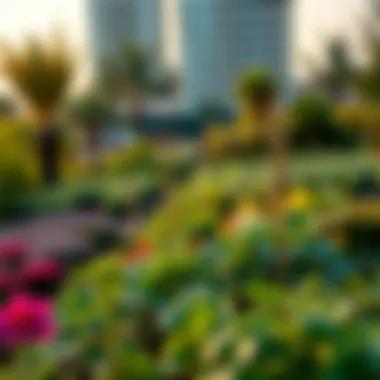
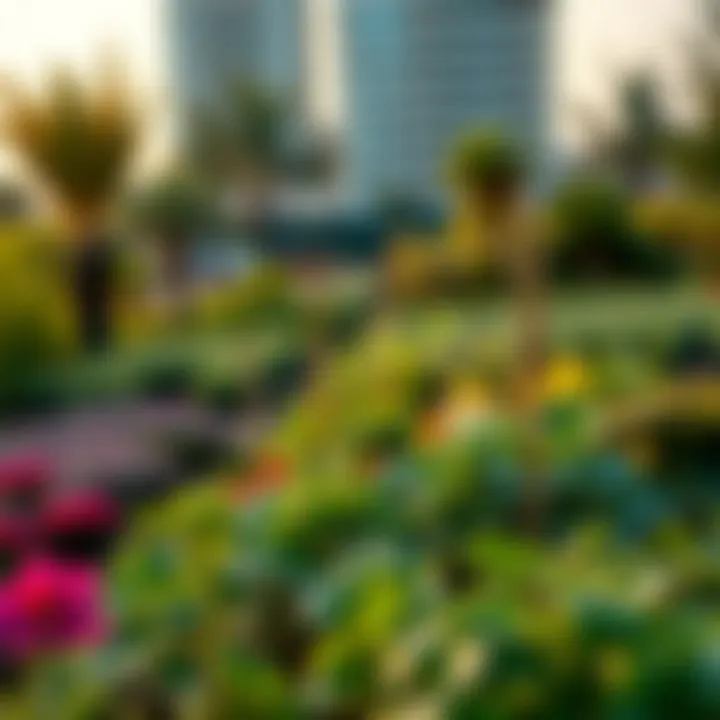
- Increased Awareness: When community members participate in sustainability programs, they become more aware of environmental issues. For example, educational workshops teach the importance of conserving water and reducing waste, encouraging residents to change their habits.
- Enhanced Quality of Life: Engaged communities often experience an enhanced quality of life. Green spaces created through community efforts, such as community gardens or urban farms, improve air quality and provide a pleasant setting for residents to relax.
- Strengthened Social Bonds: Working together on sustainability projects fosters camaraderie among locals, forging relationships that can last a lifetime. When neighbors unite for a common purpose, it strengthens the social fabric of the community.
Despite these clear benefits, community engagement does come with challenges. It requires ongoing effort to maintain enthusiasm and commitment from participants. Getting people involved, especially in a bustling city like Dubai where time can be scarce, can be a tough nut to crack.
Educational Programs and Workshops
Educational programs and workshops serve as the bedrock for cultivating sustainability-minded citizens. In Dubai, these programs are often organized by local governments, nonprofit organizations, and various community groups. They cover a wide range of topics like water conservation, energy efficiency, and waste management, providing the knowledge necessary to make informed choices.
These seminars frequently draw crowds, especially when interactive elements are involved. For instance, workshops teaching residents how to compost at home have gained a following. When participants get hands-on experience, the knowledge sticks, like glue. This participatory approach not only educates but empowers individuals to take action in their daily lives, ultimately contributing to a greener city.
Local Initiatives and Volunteerism
Local initiatives play a pivotal role in the sustainability landscape of Dubai. The community has seen a variety of grassroots movements aimed at promoting eco-friendly practices. One notable example is the community clean-up drives held monthly in different neighborhoods. Residents come together to clean parks and beaches, effectively transforming these spaces while fostering a sense of pride in their environment.
Moreover, volunteerism is a key aspect of these initiatives. Volunteers provide hours of labor and creativity to make a significant impact. For instance, the Dubai Environmental Volunteer Program invites participants to sign up for various activities, from planting trees in parks to leading educational sessions for younger generations.
By combining local initiatives with volunteer efforts, a ripple effect occurs. Not only do these actions help beautify Dubai and make it more sustainable, but they also create a culture of responsibility.
"Your local involvement today lays the groundwork for your community’s future tomorrow."
Challenges and Considerations
The journey towards sustainability in Dubai, though commendable, is fraught with challenges that demand careful navigation and consideration. As the city continues to develop its green initiatives, a critical examination of the trade-offs involved, particularly between progress and preservation, is essential. Addressing these challenges effectively can lead to not only a sustainable urban environment but also a resilient community that thrives in harmony with its surroundings.
Balancing Development and Environmental Concerns
In the fast-paced environment of a burgeoning metropolis like Dubai, achieving the right balance between development and environmental stewardship can feel like walking a tightrope. With rapid urbanization, the demand for housing, infrastructure, and business facilities keeps rising. However, one must remember that unchecked development can lead to adverse effects like habitat loss and increased pollution.
- Urban Expansion vs. Green Spaces: As projects for residential and commercial buildings increase, the amount of available green space diminishes. Urban planners and stakeholders face the pressing question: how to expand while maintaining the ecological balance?
- Water Resources Management: Water in Dubai is a scarce commodity. The developments should incorporate water-saving technologies, and its conservation must remain integral to planning initiatives. This is particularly important given the region's climate and natural resource limitations.
Finding innovative solutions to these issues can yield fruitful results. For example, integrating vertical gardens or rooftop greenery can not only provide beauty but also improve air quality and reduce heat absorption—simple yet effective methods to harmonize nature within urban settings.
"Sustainability is not a buzzword; it's a responsibility we owe to future generations. Only by blending innovation with conservation can we create a livable city for all."
Policy Implications and Regulations
Regulatory frameworks play a pivotal role in shaping the direction of sustainable initiatives in Dubai. Clear and robust policies lay the groundwork for effective implementation and monitoring of environmental practices. Here are a few considerations surrounding policy implications:
- Zoning Laws: Adjustments in zoning regulations can allow for the integration of green infrastructures like parks and conservation areas. By establishing standards that prioritize sustainability, the authorities can enforce compliance and incentivize developers to consider eco-friendly approaches.
- Renewable Energy Mandates: Policies encouraging the use of solar and wind energy in new buildings can lessen dependency on non-renewable resources. The Dubai Clean Energy Strategy 2050 provides a framework for necessary transitions, but its success heavily relies on adherence and innovation from both the private sector and government.
- Public Awareness and Engagement: Regulations should not merely focus on enforcement but also promote awareness. Policies aimed at educating the public about sustainable practices can empower communities to take ownership of their environment. Such community engaging programs can bring forth innovative ideas to foster participation in sustainability initiatives.
Through thoughtful regulations and practices, Dubai can ensure that it not only aspires for a greener future but also actively implements strategies that embrace a sustainable mindset across various sectors. All stakeholders, from residents to legislators, must recognize their role in this endeavor.
The Future of Green Dubai
As cities worldwide confront the intricate challenges of sustainability, the future of Green Dubai stands as a beacon of hope and innovation. This city, known for its iconic skyline and rapid development, is now venturing toward a more sustainable urban ethos. A blend of tradition and modernity is becoming hallmark of what residents and visitors can expect in coming years.
Long-Term Sustainability Goals
Dubai's aspirations for sustainability are underscored by a set of long-term goals aimed at reducing its ecological footprint while enhancing the quality of life for all its inhabitants. These goals align closely with the broader global agenda on climate change and sustainable urban development.
Increasing the share of renewable energy in the city’s energy mix is a pivotal aim. The goal is to have at least 75% of Dubai's energy needs met by renewable sources by 2050. This ambitious target necessitates investments in solar and wind technologies, with projects like the Mohammed bin Rashid Al Maktoum Solar Park leading the way.
Moreover, enhancing public transport options plays a crucial role in achieving sustainability objectives. The expansion of the metro system, along with integrating electric buses and trams, aims to make public transit more compelling than driving individual cars.
While these plans look promising, they aren't without their challenges. The city's rapid growth continues to pose difficulties in terms of land use and resource management. Balancing development with environmental preservation will be a key consideration as strategies unfold.
Here are some specific elements of the long-term goals:
- Reducing greenhouse gas emissions: Targeting a 30% decrease by 2030.
- Enhancing green spaces: Plans to allocate more land to parks and community gardens by 2025.
- Promoting green building standards: Incentives for constructing environmentally friendly buildings are crucial for future developments.
Global Influence and Leadership in Sustainability
Dubai's commitment to sustainability positions it as a potential leader on global platforms. By sharing knowledge and practices, it can inspire other megacities to adopt similar initiatives—creating a ripple effect in the field of sustainability.
Partnerships with international organizations and access to platforms like the World Economic Forum have already enabled Dubai to showcase its sustainable projects, such as the hosting of the Dubai Expo 2020, which emphasized sustainability as a core theme. These initiatives serve not just as an opportunity for the city but also reflect its ambition to influence global best practices in urban sustainability.
As Dubai forges ahead, its leadership will likely focus on:
- International Collaboration: Engaging with global experts and nations to exchange strategies and innovations.
- Showcasing Success: Promoting successful projects and initiatives that serve as blueprints for other cities.
- Investment in Research: Committing funding for research and development in sustainable technologies.
“A city that leads with its heart and mind, showing the world that sustainability isn't just a journey, but a shared obligation.”
The future of Green Dubai is more than just a lofty vision; it represents a transformative journey towards resilience in the face of climate change. This path, paved with innovative solutions and global collaboration, holds the potential to shape not only the future of the city itself but also to set a precedent for urban living worldwide.
Through this endeavor, Dubai is not merely keeping pace with global trends but is on its way to becoming a cornerstone of sustainable urban living.



